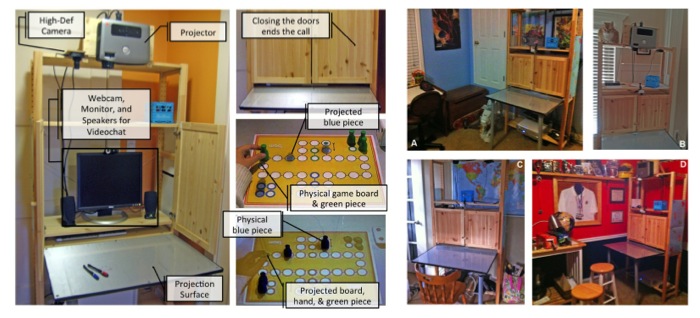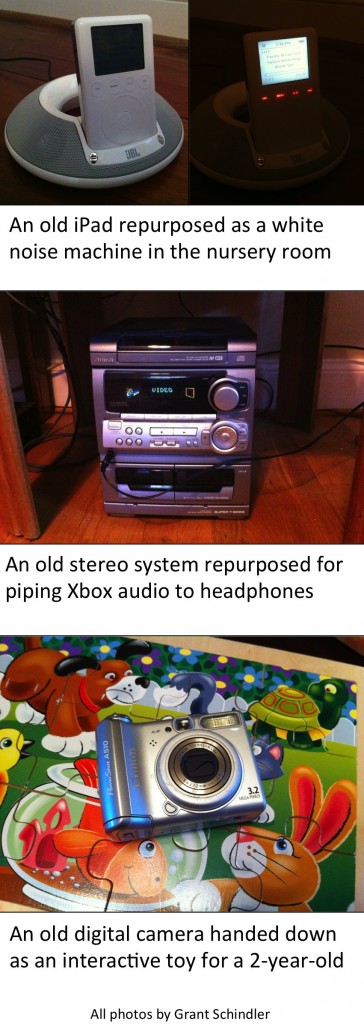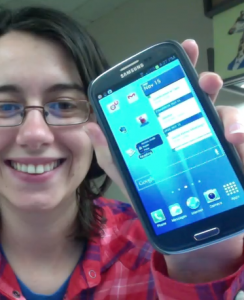The ShareTable was my Ph.D. thesis project and the paper about its deployment will be presented at CSCW 2013. Since everything is officially accepted, I thought that I’d give y’all a preview of the paper and summarize a few of our findings. I’m also going to give an overview of our process, which may be helpful to other students who are in the same boat.
We wanted to address two common issues in remote parent-child communication that we discovered through interviews with divorced families: (1) children don’t feel empowered to initiate the interaction and (2) its hard to have a longer interaction because just talking is boring for the child. To address these challenges, we designed and deployed the ShareTable — a system that provides easy-to-initiate videochat and a shared tabletop task space — in four divorced households. We compared the families’ previous communication practices (from a 2-3 week diary baseline study) with their use of the ShareTable system. Throughout the month of its use, the families employed the ShareTable to participate in shared activities, share emotional moments, and communicate closeness through metaphorical touch. The amount of parent-child communication more than doubled for both families because doing activities together was more compelling than just talking. Additionally, children initiated a much greater proportion of conversations over the ShareTable than they had previously done with the phone. However, the ShareTable did also introduce new concerns over privacy and new sources of conflict about appropriate calling practices between the parents. Overall, our experience showed that the combination of videochat and an activity space provided a compelling medium for communication with young children. A similar approach may be useful with other types of geographically-separated families, as well as in supporting children in remote play and learning.
I also wanted to reflect a bit on the whole process. While I was working on this project, I frequently felt frustrated and like things weren’t moving along fast enough. Indeed, there were a lot of times that I ended up backtracking on ideas, rewriting the code (twice completely ), and reconsidering the best way to approach the whole idea. However, reflecting back on it, that’s a kind of progress as well and perhaps that’s what research is all about. Indeed, even in the slowest of years, I made some progress on the overall idea. Sketches (while they almost seemed a waste of time while I was doing them) turned out to be a great way of getting early feedback on my ideas, considering alternatives, and most importantly attracting good people to this project. The design would not have been possible without Stephen Cuzzort, Hina Shah, Hendrik Mueller, Brian Di Rito, and Berke Atasoy. The implementation would not have happened without Stephen Cuzzort, Jee Yeon Hwang, Sanika Mokashi, Shashank Raval, Duane Rollins, Jasjit Singh, and Anthony Tang (even if not everybody’s code ended up in the final system). And there was no way I could have deployed it in the homes without Sanika Mokashi, Yi Han, Eugene Medynskiy, Kurt Luther, David Quigley, Caleb Southern, and Jay Summet (there was a lot of truck driving and furniture-moving involved!). And, of course, my advisor Gregory Abowd was there every step of the way.

The process of developing this system took several years, granted with a lot of side projects and learning along the way.
So, if you are currently a Ph.D. student and you’re feeling like you’re climbing a never-ending mountain, keep at it, you’ll feel great when you reach the top! In the meantime, try to find good people to help. Even though it’s only my name on the thesis, the giant list of names above shows that I couldn’t have done it alone. Ask for help when you need it!



